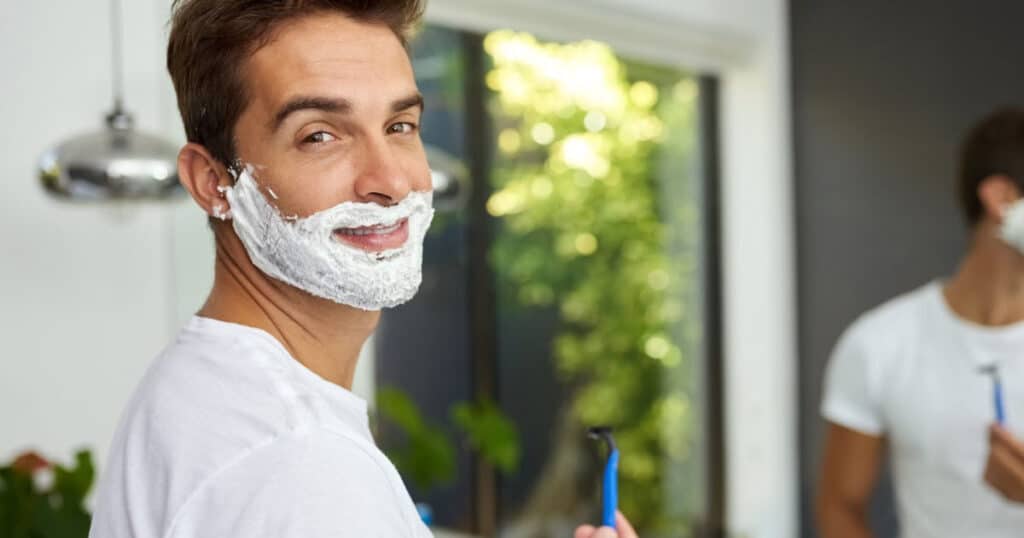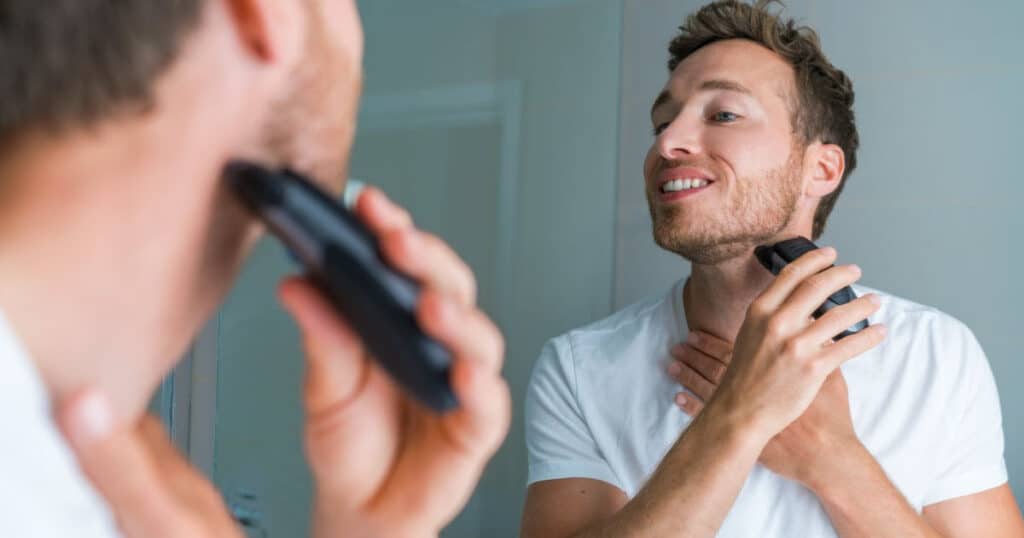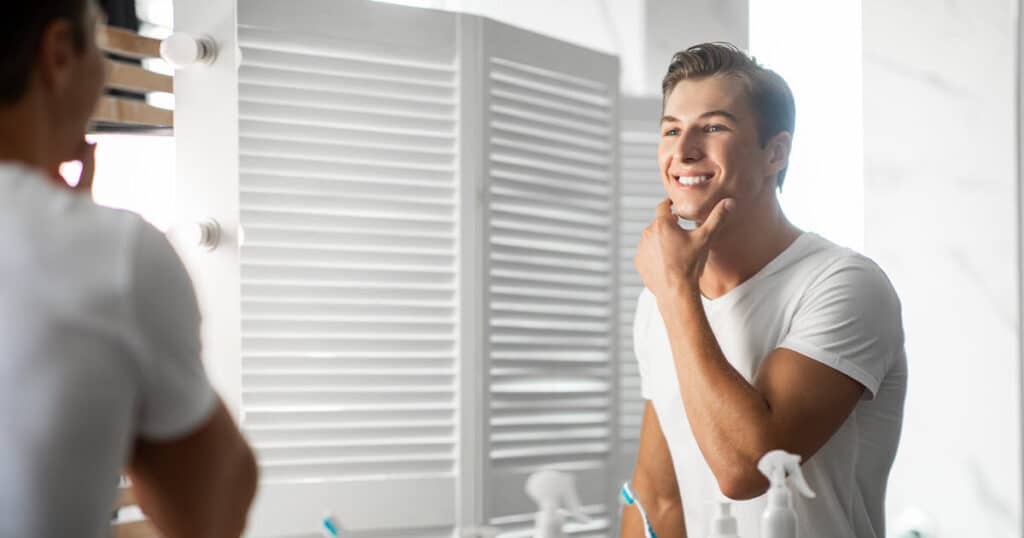Your skin is the largest organ on your body, and it is your first line of defense from the outside world. We hate to put things in militaristic terms like that—we’re primarily a men’s grooming site, so it’s not in our nature to be so tense—but it’s true: your skin defends against bacteria, viruses, and just about everything else that’s trying to destroy you.
So it’s up to you to keep it healthy. There’s a lot that can go wrong, and you need to know what’s out there.
And that’s what this post is about: the most common skin disorders for men, how to avoid them if you don’t have them, and what to do if you get one. We’re not just talking razor burn and shaving nicks—we’re talking about a wide range of things that can go wrong on the outside of your body.
Fun, right? Well, no. But it’s important. So here we go. First up!
Actually, No… Let’s Begin with a Disclaimer
We should probably say, before we get started, that we, the writers of Rough and Tumble Gentleman, are not doctors. We’re not medical professionals of any kind. We don’t understand basic facts about science or biology or math, and it’s likely that one of our writers is borderline illiterate (looking at you, Carl). We are in no way qualified to give real, substantive, medical advice, and none of this should be seen as medical advice, and you shouldn’t take it as such. If you’re sick, or think you’re sick, stop reading this post, and go to a doctor.
OK, first up:
Acne: Everybody Gets It
It may come as a surprise, but the most common skin disorder on planet Earth is acne. Most people get acne at some time in their lives, and luckily, most people get past it without too much effort. Most men who suffer through acne during their teen years have little-to-no acne as they move through their 20s and 30s. So that’s nice. For those gentlemen who have ongoing difficulties with acne, the cause can be almost anything, from environmental factors, to dietary habits, to allergies, to medication, to glandular disorders. Not only do acne-sufferers commonly dislike the look of their acne, but it can also hurt quite a bit.
A visit to your primary care doctor would be your first option, followed by a trip to a dermatologist. For research, there’s a lot of great information at Acne.org, and you can also visit their forum, which is a treasure trove of anecdotal knowledge—and anecdotal knowledge can be quite worthwhile when combined with proper research—and it’s also a great place for support, as well.
Razor Burn: What It Is and How to Avoid it
Razor burn is the bane of existence for guys who want to shave, but haven’t figured out how to make it work for themselves yet. There are a lot of reasons why it happens, but the most common is this: when you have a multiple-blade cartridge or disposable razor, and you drag that razor across your skin, you sometimes actually shave the whisker at its root below the skin. When that happens, and the whisker continues to grow, it doesn’t exit the skin properly, and instead curls up underneath the skin and tries to break through. The result is redness and irritation and bumps.
If you suffer with razor burn, here are some pointers:
Think About Using a Safety Razor. If electric shavers and cartridge razors are messing you up, consider using a safety razor with a single blade. There’s a learning curve with safety razors—aka, you’re going to cut your face a lot when you first start using them—but the single blade works like a charm for a LOT of guys.
Be Careful with Electric Shavers. These have a tendency to lift your whiskers before cutting them, setting the stage for razor bumps. This also goes for many of the multi-blade and cartridge and disposable razors, too—the first blade “lifts” the whisker, and the second/third/fourth blade cut the whisker below the base.
Make Sure Your Blade Is Sharp. Using an old razor is a formal invitation for razor burns. The gaps and inconsistencies in the blade will irritate your skin in a bad, bad way.
Lather Up. Use a lather or cream to soften the skin, and consider using a pre-shave oil after you get out of the shower, but before you shave. They can make a big difference.
Shave with the Grain. Some guys simply can’t shave against or across the grain, no matter what time of razor they’re using. Do a little experimenting, and find out if that’s the problem.
If you’ve got razor burn, it’s a waiting game until they pass. You can use Vitamin E, aloe vera, or an aftershave (without alcohol) to soothe the skin a little bit.
Sunburn: More Than Just a Burn
No need to go too deep into this. No matter who you are, you need to protect your skin. Wear sunscreen and if you’re going to be out in the sun all day—at the beach, on the softball field, hiking, or even if you work outside—make sure you’re taking care of yourself. Skin cancer (which we discuss below) is really common, and it can be caused from severe sunburns, and you don’t want it. So take the time to apply suntan lotion whenever you’re out in the sun.

Rosacea: Very Common
Another super-common skin disorder, that’s very common for people with Northern European ancestry—rosacea affects 14 MILLION people in the United States. That’s a lot.
So what is it? Basically, it’s an inflammatory disorder wherein the blood vessels in the skin dilate, and appear reddish or maroon or pink. This is more of a cosmetic issue than a medical one, but that doesn’t mean it’s not a concern for a lot of guys: it can cover parts of the skin, and it can expand over time.
If you’ve got this—and like all these disorders, you should give your face a quick once-over when you’re shaving, to make sure it doesn’t develop—but if you’ve got this, you can visit a dermatologist and get medication to combat it. There are also over-the-counter remedies, such as green tea treatments and face washes. You can also wear a cosmetic to conceal it—and, yes, a lot of guys won’t be on that, especially on a day-to-day basis, but it’s not uncommon at all for guys on their wedding days (or other big events) to wear a cosmetic concealer of some sort. After all, you want to make sure you get you get your money’s worth—those photographers are expensive!
Eczema: Uncomfortable
Remember how we just said that over 14 million people have rosacea? Over twice that number—31 million—get eczema.
If you don’t know what eczema is, consider yourself lucky. It’s a scaly growth the covers small-to-large swaths of the skin (usually on the elbows and arms and hands), and it’s veeeery uncomfortable. Some people report that it’s difficult to take care of day-to-day tasks, because the itch is so distracting. Plus, because it’s itchy, there’s the possibility of other skin infections—people with the disorder often can help but scratch away, and that’s where they get in trouble.
Aside from all this, though, there’s a social aspect to this disorder (as there is with a lot of these disorders): it’s very visible, and others are very, very concerned about getting it. It’s not contagious, but most people act like it is, and if you do any activity where your skin is showing and you need to interact with others—so that’s basketball, MMA, dance, whatever—chances are you’re going to get some weird looks and some weird comments. It’s a bummer.
Doctors aren’t sure how eczema starts, and it’s got a couple triggers (stress is one of them; dry climates is another). There are steroidal creams that doctors can prescribe, as well as oral medications. If you’ve got this, or are worried you do, definitely go see a doctor or dermatologist.
Athlete’s Foot: Itchy AND Painful
This is another one where you’ll know for sure if you’ve got it. The itch that athlete’s foot can create is SURPRISINGLY strong. It’s caused by a fungus that you usually catch in warm, moist environments like a gym shower or a spa or an indoor pool.
The over-the-counter treatments work pretty well, and you can go to any Rite Aid or CVS and pick them up. For really bad cases that simply won’t go away, call your doctor.
Rashes from Plants and Allergenic Chemicals
This is a non-descript one, but it’s important to mention. Our skin is in almost constant contact to a whole slew of very, very weird chemicals. From the laundry detergent you clean your clothes with, to the soaps you use, to the plants you brush against at any time during the day. There are some people who can touch just about anything and be fine, and there are others who really need to be mindful about what’s coming into contact with the skin. If you’re breaking out in a rash or reaction, take the time and do a full inventory of everything that touches the skin. If it’s suspect, experiment and see if it’s bothering you, or simply go to an allergist. Many people say that their first trip to an allergist changed their lives, and if you’re breaking out all the time, why suffer?
Psoriasis: Blistery Scales
This is another heartbreaking one. Psoriasis is a chronic skin condition that results in blistery scales on the skin. Scientists aren’t sure why it occurs, but they believe that there’s a genetic component to it. It’s very itchy, can cover a lot of the skin, and it’s very visible to others. Just like eczema, there’s a social aspect to the disorder, and people who suffer from it can be very self-conscious about it. And, just like eczema, people are worried that it’s contractible, and act very weird around people who have it.
Unfortunately, there’s no clear way to prevent it, but there are a number of different treatments, both topical and oral. Light therapy is also an option that works for some people.
Wrinkles: Waiting for All of Us
Here’s the thing about wrinkles: once you have them, you have them. Unless you’re down for plastic surgery—and most people aren’t—you’re stuck with the wrinkles you get.
So, as with most of these conditions, prevention is key, and the two best things you can do for your skin is 1) Be responsible in the sun and wear sunscreen (and avoid the sun if you need to—some people are suuuuuper pale, and need to be careful about such things) and 2) stop smoking cigarettes. If you smoke cigarettes, you’re almost ensuring that you will have a ton of wrinkles when you’re older.
That second one is something we should remark on. If you’re a smoker, do whatever it takes to stop. It’s NOT easy—we totally get that—but it’s just so, so bad for you. There are a lot of places online where you get support, and you should definitely check them out.
OK. Holier-than-thou rant over. Sorry.
If you’re really motivated about avoiding wrinkles, adopt a skin care regimen. There are men’s skin care products made specifically to fight aging and a daily moisturizer will go a long way.

You Don’t Want Groin Rash
Yeah, man—groin rash. You don’t want that.
It’s red, splotchy, and it itches, and it’s the part of your body where you particularly don’t want rashes. It’s usually a problem for guys who sweat a lot, and it’s related to the fungus that causes athlete’s foot.
If you are an excessive sweater, you should do the following:
Shower a Lot. Bathe, man! It’s good for you. If it’s not part of your routine, make it a part of your routine. Why risk GROIN RASH?
Changes Your Clothes. Rewearing the same thing—particularly your boxers or briefs—for more than a day at a time is an invitation for funk. Bacteria and all sorts of nasty stuff thrives in an environment like that, so change your clothes, and in particular, change your undergarments. PARTICULARLY if you live in a hot climate.
Take a Minute and Get Dry. If you’re feeling sweaty for a prolonged period of time, take a minute, remove yourself to a private place, and air out.
If you do get groin rash, a doctor or dermatologist can give you an anti-fungal lotion or spray, and that usually takes care of things.
The Big One: Skin Cancer
In the United States, skin cancer is the most common forms of cancer, and 1 in 5—yes, ONE in FIVE—Americans will suffer from skin cancer at some point during their lives.
There is a genetic factor at play, BUT—your actions have a direct impact on the odds of you developing skin cancer. Skin cancer is perhaps the only form of cancer that you can take effective preventative measures to avoid: yes, sunblock. Use sunblock. Don’t be dumb about this. No matter how light or dark your skin, you need to use sunblock.
Fun fact: did you know that having a beard provides UPF (Ultraviolet Protection Factor) protection for the skin underneath your beard? True! You still need to use sunblock on every part of your body, but it’s nice to know that your beard is there to protect you.
Stretch Marks: More Common Than You’d Think
Let’s be honest: the United States—as well as the rest of the developed world—has faced something of a weight crisis in the last few decades. If you lived before World War II, chances are, if you were obese, you were wealthy. Now, you just look kind of normal. It’s a huge bummer, and it may not happen in your teens or early twenties, but if you’re not vigilant, the chances of you putting on a couple of extra pounds is very, very likely.
If you’ve got stretch marks, you can treat them with Vitamin E (known for its curative properties—it works great on any type of skin scar) and/or aloe vera, but the best cure for stretch marks is prevention. As early in your life as you can, learn how to eat healthy and find a type of exercise that feels like play.
Moles and Other Marks
You know what a mole is. It’s a brown or black shape on some part of your body. In-and-of-itself, there may be nothing wrong with a mole here and there, but you want to keep an eye out for any changes in the mole’s size, shape, color, and 3-D properties (if it was once flat, and now is raised in certain areas, that could be bad).
If you’ve got moles, or you know have moles and you never used to, definitely see a dermatologist and ask them what’s up. They usually recommend a once-a-year check-up to make sure the moles aren’t dangerous.
You’re It: Skin Tags
These are small bits of skin tissue that are slight raised above the skin. They’re very common the shoulders, neck, and armpits, although they sometimes appear on the face. They’re not usually dangerous, but many find them “aesthetically displeasing,” so if you find that you have a few that pop up, you can visit a dermatologist, and they can snip them off. It doesn’t usually hurt. Plus, they’re not contagious, so you can have them clipped without any fear of them spreading to other parts of your body.
They’re common in older people, and if you put on a lot of weight, they can pop up, as well.
Hives: Also Awful
These are nooooooooooooo fun. They can be an unconnected archipelago of small bumps or a red sheet that spreads across your skin, but they hurt like a mother. For some people, they’re itchy; for others they smart like a bee string.
This is another condition that seems like it can come out of nowhere, but there are usually some reliable sources, particularly allergies: if you’re getting hives, be sure to look at the medications you’re taking, and look at the ingredients list for all the foods you’re eating and the grooming products you use.
That said, hives can pop up for much simpler reasons, like being in extremely warm temperatures, or from experiencing incredible stress.
If you’re suffering from hives, take a look at the things you’re ingesting and putting on your skin, but also take a look at your anxiety levels. If you’re compulsively worried or nervous about something, stop and be mindful of it. Relax, take a deep breath, maybe do a little meditating. It may not make the hives immediately disappear, but it’ll certainly make you feel better.
Cold Sores, aka Fever Blisters, aka You Know Someone Who Has These
If you get these, you know that shaving around them can be… we’ll put it lightly, and say “Agonizing.”
Cold sores are a result of the herpes simplex virus, and you can see them around the mouth (usually on the lips), although sometimes they travel north to the nose. They last a week or two, and are more likely to pop up during times of stress, illness, or hormonal variations (for women, it’s not uncommon for cold sores to pop up around menstruation).
There’s not too much you can do about these—most people just wait until they pass—but there are topical creams you can use. If they’re getting really bad, definitely visit a doctor to find out what’s going on.
Warts on the Skin
These usually occur on the fingers or hands, but it’s not uncommon for them to spread to the face—and that makes shaving very difficult. In fact, it can make shaving a little dangerous—warts spread when they’re opened, and dragging a razor over the top of a wart is definitely going to open it up so that the virus (the human papillomavirus) can spread to other parts of the skin that may also be open.
Warts usually go away after a few years, but if you don’t want to wait that long (and who wants to wait a few years for warts to disappear?) there are over-the-counter treatments, home remedies, and strategies strategies dermatologists can use.
So How Can You Avoid All This?
We’ve spent the entire article scaring you, and let’s be honest, here: this post is kind of a downer. It’s full of disorders and advice on what you need to do to avoid them. No fun.
So how can you avoid the disorders above? Here are the easiest ways.
Be Vigilant. Keep an eye out during your daily grooming routine. When you’re shaving, give yourself a quick look to see how your skin is doing.
An Ounce of Prevention is Worth a Pound of Cure. Some of the disorders above are genetic, and you may be at an elevated risk, but others are very avoidable. If you take a shower at the gym, wear flip flops to avoid athlete’s foot; if you’ve got pale skin, cover and wear sunscreen.
Accept the Genetic Components of Certain Disorders. If you’re prone to a particular disorder, don’t pretend you’re not! How many serious sunburns do you need to get before you say, “OK, it’s a bummer, but my first 15 minutes at the beach have to be spend applying sunscreen.”
Knowledge is Power. If you do develop one of these disorders, learn as much as you can about it. The more you know, the more likely you are to beat it. And, of course—
Get Yourself to a Doctor. If you do develop one of the disorders above, or if you think you’re at risk to develop one of them, seek professional medical treatment. Can’t hurt, right?
If you’re on the lookout for these conditions, you’re a LOT less likely to develop them. With proper hygiene and a routine skin care regimen, you can lower your chances of having to deal with these disorders. Remain ever vigilant, and protect ya neck!
Michael Morris is the head writer here at Rough and Tumble Gentleman. He's got a ducktail beard and loves Brazilian jiu-jitsu. He's married to the woman of his dreams and lives in Brooklyn, NY.




